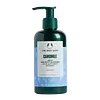What's inside
What's inside
 Key Ingredients
Key Ingredients

 Benefits
Benefits

 Concerns
Concerns

 Ingredients Side-by-side
Ingredients Side-by-side

Water
Skin ConditioningPropanediol
SolventGlycerin
HumectantDecyl Glucoside
CleansingErythritol
HumectantCarbomer
Emulsion StabilisingPolysorbate 20
EmulsifyingTapioca Starch
Xanthan Gum
EmulsifyingPhenoxyethanol
PreservativeCoco-Glucoside
CleansingGlyceryl Oleate
EmollientAnthemis Nobilis Flower Water
MaskingSodium Hydroxide
BufferingEthylhexylglycerin
Skin ConditioningCocamidopropyl Betaine
CleansingCitric Acid
BufferingTrisodium Ethylenediamine Disuccinate
Parfum
MaskingSodium Chloride
MaskingLinalool
PerfumingAloe Barbadensis Leaf Juice Powder
Skin ConditioningTocopherol
AntioxidantHydrogenated Palm Glycerides Citrate
EmollientWater, Propanediol, Glycerin, Decyl Glucoside, Erythritol, Carbomer, Polysorbate 20, Tapioca Starch, Xanthan Gum, Phenoxyethanol, Coco-Glucoside, Glyceryl Oleate, Anthemis Nobilis Flower Water, Sodium Hydroxide, Ethylhexylglycerin, Cocamidopropyl Betaine, Citric Acid, Trisodium Ethylenediamine Disuccinate, Parfum, Sodium Chloride, Linalool, Aloe Barbadensis Leaf Juice Powder, Tocopherol, Hydrogenated Palm Glycerides Citrate
Benzoyl Peroxide 5%
Water
Skin ConditioningPolyacrylamide
C13-14 Isoparaffin
EmollientGlycerin
HumectantJojoba Esters
EmollientSodium Glycolate
BufferingCarbomer
Emulsion StabilisingDiethylhexyl Sodium Sulfosuccinate
CleansingCocamidopropyl Dimethylamine
EmulsifyingCocamidopropyl Betaine
CleansingLaureth-7
EmulsifyingSodium Chloride
MaskingSodium Citrate
BufferingSodium Hydroxide
BufferingPropanediol
SolventEthylhexylglycerin
Skin ConditioningPhenoxyethanol
PreservativeBenzoyl Peroxide 5%, Water, Polyacrylamide, C13-14 Isoparaffin, Glycerin, Jojoba Esters, Sodium Glycolate, Carbomer, Diethylhexyl Sodium Sulfosuccinate, Cocamidopropyl Dimethylamine, Cocamidopropyl Betaine, Laureth-7, Sodium Chloride, Sodium Citrate, Sodium Hydroxide, Propanediol, Ethylhexylglycerin, Phenoxyethanol
 Reviews
Reviews

Ingredients Explained
These ingredients are found in both products.
Ingredients higher up in an ingredient list are typically present in a larger amount.
Carbomer is a polymer of acrylic acid. Its main role is to create a gel consistency.
A high amount of carbomer can cause pilling or balling up of products. Don't worry, most products contain 1% or less of carbomer.
Cocamidopropyl Betaine is a fatty acid created by mixing similar compounds in coconut oil and dimethylaminopropylamine, a compound with two amino groups.
This ingredient is a surfactant and cleanser. It helps gather the dirt, pollutants, and other impurities in your skin to be washed away. It also helps thicken a product and make the texture more creamy.
Being created from coconut oil means Cocamidopropyl Betaine is hydrating for the skin.
While Cocamidopropyl Betaine was believed to be an allergen, a study from 2012 disproved this. It found two compounds in unpure Cocamidopropyl Betaine to be the irritants: aminoamide and 3-dimethylaminopropylamine. High-grade and pure Cocamidopropyl Betaine did not induce allergic reactions during this study.
Learn more about Cocamidopropyl BetaineEthylhexylglycerin (we can't pronounce this either) is commonly used as a preservative and skin softener. It is derived from glyceryl.
You might see Ethylhexylglycerin often paired with other preservatives such as phenoxyethanol. Ethylhexylglycerin has been found to increase the effectiveness of these other preservatives.
Glycerin is already naturally found in your skin. It helps moisturize and protect your skin.
A study from 2016 found glycerin to be more effective as a humectant than AHAs and hyaluronic acid.
As a humectant, it helps the skin stay hydrated by pulling moisture to your skin. The low molecular weight of glycerin allows it to pull moisture into the deeper layers of your skin.
Hydrated skin improves your skin barrier; Your skin barrier helps protect against irritants and bacteria.
Glycerin has also been found to have antimicrobial and antiviral properties. Due to these properties, glycerin is often used in wound and burn treatments.
In cosmetics, glycerin is usually derived from plants such as soybean or palm. However, it can also be sourced from animals, such as tallow or animal fat.
This ingredient is organic, colorless, odorless, and non-toxic.
Glycerin is the name for this ingredient in American English. British English uses Glycerol/Glycerine.
Learn more about GlycerinPhenoxyethanol is a preservative that has germicide, antimicrobial, and aromatic properties. Studies show that phenoxyethanol can prevent microbial growth. By itself, it has a scent that is similar to that of a rose.
It's often used in formulations along with Caprylyl Glycol to preserve the shelf life of products.
Propanediol is an all-star ingredient. It softens, hydrates, and smooths the skin.
It’s often used to:
Propanediol is not likely to cause sensitivity and considered safe to use. It is derived from corn or petroleum with a clear color and no scent.
Learn more about PropanediolChances are, you eat sodium chloride every day. Sodium Chloride is also known as table salt.
This ingredient has many purposes in skincare: thickener, emulsifier, and exfoliator.
You'll most likely find this ingredient in cleansers where it is used to create a gel-like texture. As an emulsifier, it also prevents ingredients from separating.
There is much debate on whether this ingredient is comedogenic. The short answer - comedogenic ratings don't tell the whole story. Learn more about comegodenic ratings here.
The concensus about this ingredient causing acne seems to be divided. Research is needed to understand if this ingredient does cause acne.
Scrubs may use salt as the primary exfoliating ingredient.
Learn more about Sodium ChlorideSodium Hydroxide is also known as lye or caustic soda. It is used to adjust the pH of products; many ingredients require a specific pH to be effective.
In small amounts, sodium hydroxide is considered safe to use. However, large amounts may cause chemical burns due to its high alkaline.
Your skin has a natural pH and acid mantle. This acid mantle helps prevent harmful bacteria from breaking through. The acid mantle also helps keep your skin hydrated.
"Alkaline" refers to a high pH level. A low pH level would be considered acidic.
Learn more about Sodium HydroxideWater. It's the most common cosmetic ingredient of all. You'll usually see it at the top of ingredient lists, meaning that it makes up the largest part of the product.
So why is it so popular? Water most often acts as a solvent - this means that it helps dissolve other ingredients into the formulation.
You'll also recognize water as that liquid we all need to stay alive. If you see this, drink a glass of water. Stay hydrated!
Learn more about Water